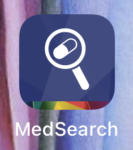It used to be that inside every packet of medicine there was a printed sheet with information about the drug. What it was, what it contained, what it was for, how to use it, possible side-effects to watch out for, how to store it safely, etc. Often this is printed on very thin paper to make it fit into the box!
This information sheet is the CMI: the Consumer Medicine Information that has to be provided with every medicine in Australia.
But wait, what’s that? The box of medicine you got from the pharmacy doesn’t have that sheet in it? This is a change that was brought in some years ago.
If it’s the first time you’ve used a drug, the pharmacist discusses it with you, and can provide you with a printed copy of the CMI. But there’s not an extra printed copy in every box of every medicine (some yes, many no).
But wait, what’s that? The pharmacist didn’t give you that CMI? Maybe you brushed them off and told them you’d had it before. Maybe you had it but lost it. Or a million other reasons why you don’t have the CMI. But now you’re wondering if there was something you were supposed to know about the medicine. Maybe your nose is itchy and you’re wondering if it’s listed as a possible side-effect.
Find it yourself!
But all is not lost. Thanks to the power of the internet, you can access the information for almost all the medicines available in Australia. These documents (in PDF form) are available from the TGA. For example, here are the current CMIs for Ozempic and for NovoRapid insulin vials.
To find these, head to the search page at the TGA.

The site should work on both a desktop web browser and mobile phones, but there’s also a dedicated TGA phone app: MedSearch.
I hope this is useful to you!
A note about “side-effects”
I see some people worrying about the long lists of possible effects listed for some medications. We do need to remember that most of these things are not likely to happen to us.
Having participated in clinical drug trials, I know they have to record every symptom/occurrence that goes on. For example even if a headache wasn’t actually caused by the drug, unless they can prove that it wasn’t, it has to get listed as a possible side-effect.
So a list of possible side-effects is not even a list of things that are “likely” to happen to us. Just things that if we notice we should probably pay attention to and investigate further (for example by consulting with our doctors) just in case they’re related to the medicine.



Thanks David, this is good to know. In the same time the information on those PDFs is so limited compared to the full info normally supplied with the same drug I other countries. Usually those include all the ingredients, often with the principal action and effects explanation, interaction with other drugs and so on.
Those probably doesn’t classify as consumer information, but makes much easier to understand for somebody who want it. Not sure I understand the reasoning for excluding even from prescription based drugs.
The “PI” documents available at the same place are targeted at healthcare professionals, and may have some of the info you’re referring to. They are accessible to us even if we’re not expected to read them.
Ah yes, I see, thanks! Didn’t notice on the mobile site, but it is indeed available.